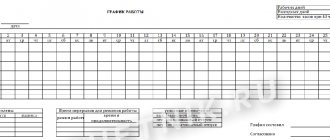Skip to content
iQ Review Independent journalism
.
04/13/2018 at 17:54 15 min. 9896
Shift work - what is it? How does it differ from other types of activity, what features and nuances does it involve?
The rotation method is one of the options for work that is not performed at the person’s place of residence. In this case, the employee’s daily return home is impossible. Nowadays, this kind of work option occurs when we are talking about seasonal employment, work in timber and oil extraction. People also work in this way in fishing, while searching for deposits of precious metals and stones. Seasonal shift work is also different, most often relevant in the summer.
- Shift work - what features need to be understood?
- Working as a shift worker in the north - what are the conditions and nuances?
- Remuneration: why is working as a watchman profitable?
- What payment options are there?
- What should you know before your trip?
- Shift work. Detailed video
How to understand the shift work method, what it is
This is the name for permanent or shifting (seasonal) activity, where people do not return home during the day, but rest on the territory of the organization in specially designated places.
This is a specific form of labor relations, therefore separate acts have been thought out for it, which we will discuss below.
A company can introduce a similar type for certain specialties, people, or for all its employees at once. For example, if a company is located in a sparsely populated region, then it is better to recruit managers and specialized professionals for shifts. So they will be constantly in production.
If workers have to travel to and from work every day for more than 3 hours every day, then it is better to prepare an order and invite them to work on a shift basis.
Most often this is practiced in areas of the Far North and equivalent areas, as well as in areas where it is necessary to quickly erect a new workshop, open an enterprise or build a building.
The main challenge of the approach is the need for a large amount of labor. Despite the fact that such work is paid more expensively and requires more effort and money to set up, companies are willing to do it. Because the result and an established production process are much more important. For example, in the oil industry and when constructing bridges, it is important to comply with all technological and time standards.
Work and rest schedule during shifts according to the Labor Code
The work and rest regime when organizing work on a rotational basis is reflected in a special schedule, which is developed and approved by the employer, and the opinion of the elected body of the trade union organization must be taken into account. The developed local regulatory act is required to be studied by all employees of the organization with whom labor relations of this kind are formalized. Employees must be familiarized with this document no later than 2 months before its approval and entry into force.
In addition to the shift work schedule, the schedule also includes the time required to transport employees from the initial assembly point to the final point of performance of their work duties and back. This time is not included in the working period, and therefore may well fall on days related to the period of inter-shift rest.
Regulation by law
Every person, before he finds a job under such conditions, should understand how this is reflected in the Labor Code of the Russian Federation.
Article 297 clearly states that this can be called a type of activity in which a specialist cannot return to his place of registration every day. This type cannot be classified as business trips, since a shift is considered to be working all the time, including rest between shifts and part of the day at work.
It should not last more than 1 month, but in special cases and by prior agreement, the employer can increase this period. Shift is no more than 12 hours, if more, then this is overtime, which is paid separately. The order in which shifts will take place is also determined in advance by management and specified in the documentation that the employee will sign.
Weekends during a shift are days off that are either paid according to special rules or counted towards the period when the employee will be at home. There are no holidays or vacations at the facility; rest begins only when a person gets to their place of residence.
What is working on a shift basis: what does it mean according to the Labor Code of the Russian Federation
This is a special form of the labor process, which is based on the inability to get home every day. The company undertakes to organize the transportation of people in both directions, to provide conditions for livelihoods and accommodation at the plant or near the production site.
Company order
Before making such a decision, an enterprise usually carries out calculations that help to understand how effective and expedient it is to move to this type of interaction with personnel.
If this should pay for itself, then the administration creates a document according to which it completely switches to this type or introduces it as an additional one.
The papers state:
- the fact that the company now has a similar variety;
- how time will be counted;
- for what period is it summed up;
- terms of payment;
- the level of the bonus, if there is one - in government institutions this is regulated by law;
- coefficients by region;
- “northern” allowances, if the organization is located in the relevant region;
- how long the shift is, how many days to work and rest;
- Mandatory - signatures of all employees who have read the document.
Legal regulation
Before applying for a job in a company on a rotational basis, it would be a good idea to familiarize yourself with the Labor Code of the Russian Federation; such activities are regulated by a specific article of the Law. According to Article 297 of the Labor Code of the Russian Federation, a shift is a type of legal labor activity when the daily return of a worker to his place of registration is impossible. This type of employment is not a business trip; all working time spent at production (shift) and rest between shifts are considered a shift. Registration is carried out according to the employment contract.
Working hours should not exceed one month in duration, although the employer can increase the period of service to three months, having previously justified its decision with an order indicating the reasons for the increase in shifts and facilities. The length of the working day by law should not exceed 12 hours. Anything in excess can be considered processing and is paid additionally (Part 1 of Article 299 of the Labor Code of the Russian Federation). The schedule is established by the employer.
On shift, labor time is constant, without days off, the working day is 12 hours, then taking these hours into account, overtime occurs and unused weekends remain, of which there must be at least 4 per month. These overtime hours are compensated by payment at the daily rate, or days off. Time off or vacation, in this case, is carried out outside the rotational facility at the place of residence (Part 3 of Article 301 of the Labor Code of the Russian Federation).
Often the shift is located at a considerable distance from the employee’s place of residence and you need to somehow get to the point. From the collection point, which is designated by the hiring company, to the office, the cost of travel is paid by the employer, while the days spent on travel are considered working days and are paid at the daily rate (Part 8 of Article 302 of the Labor Code of the Russian Federation). But the employee will have to get to the collection point on his own; according to the law, the employer does not pay for this period of travel, unless otherwise provided by internal orders and agreements of the shift site.
What is a shift according to the Labor Code of the Russian Federation
The rotation method is a special form of carrying out the labor process “away from home”, the basis of which is the impossibility of ensuring the daily return of workers to their place of permanent residence (Part 1 of Article 297 of the Labor Code of the Russian Federation). It is understood that the employer guarantees the provision of all living conditions, ensures vital functions, and organizes delivery from the collection point to the destination.
Order of the enterprise on the organization of rotational work
Before making a decision to introduce a rotational method of labor organization, the enterprise carries out a technical, economic, economic calculation, on the basis of which the feasibility and effectiveness of the transition to a new type of work activity is determined. The administration or manager issues an order that the enterprise transfers or introduces rotational work. Approval of the order includes:
- the fact of change, transfer and their implementation at the enterprise;
- summarized time tracking;
- for what period is the summarized working time taken into account;
- terms of remuneration, specifically:
- private enterprises set their own level of premium for shifts; in government agencies this allowance is regulated by law;
- district coefficient;
- allowance and bonus percentage “northern”;
- duration of the shift, number of days of work and days of rest;
- sometimes a list of employees who are prohibited from being involved in this type of activity is displayed;
- a note on the minutes of the trade union meeting (why is a trade union protocol needed in this case? A trade union is a means of regulating and agreeing on all the terms of an agreement with employees so that all procedural and legislative acts are observed);
- It is obligatory to note that employees are familiar with the contents of the order.
Which companies can use this method?
More often than others, it is used by those who open enterprises in the regions of the North and areas related to them. But in recent years it has been actively used in “ordinary” areas, because in the Labor Code there are no restrictions on areas, and the delivery time can be significantly reduced.
The main condition is the presence of an object, which is inconvenient to get to due to its remoteness or lack of roads. If a specialist has to travel more than 3 hours each time, then it is advisable to offer him a shift.
Sometimes the tax service tries to challenge the legality of its use, but usually the court sides with the employers.
Accommodation
It is assumed that the shift method of work involves difficult conditions not only in terms of climate, but also accommodation. Everything, however, depends on the criteria by which to evaluate the comfort of life. As a rule, shift workers have at their disposal, although small in area, fairly well-equipped resources for living. Modern modular designs allow the employing company to quickly build housing with acceptable infrastructure: water supply, electricity, heating. The structure of living quarters for shift workers, as a rule, includes dining rooms, leisure rooms, and the ability to access the Internet. The law requires the employing company to ensure a reduction in the time spent traveling for employees from their place of residence to the facility where work is expected to be performed.
At the same time, the rotational housing complex is inspected by a special commission before it is put into practical operation. Its members include representatives of the employing company, officials of the municipality in whose territory the shift will operate, in some cases, trade union employees, and specialists from various government services. Upon inspection, a certificate of acceptance of the complex into operation is supplied. The rotational camp is intended to accommodate not only hired employees who will perform targeted labor functions, but also personnel. At the same time, as soon as the work season ends (the objects are erected), everyone must leave the housing complex. An option is possible in which work on a rotational basis with accommodation is organized without the construction of a separate complex. In this case, the hiring company places people in hotels or corporate apartments.
Why is this not a business trip?
Sometimes personnel services confuse shift work with travel, but there are differences:
- Payment. A seconded specialist’s salary will include a working day and small tariff allowances. The shift worker draws up a special document in which all tariffs, terms and conditions are prescribed. Workers are considered to work full days.
- Body check. Before going to another city for a couple of days, you will not need to undergo an examination and confirm your health.
- Deadlines. There are no restrictions on weeks of stay for a business traveler. Upon his return, he goes to work. If people go to development, then they cannot be there for more than 1-3 months, after which a rest period follows.
- Goals. People go on a business trip to fulfill a specific assignment - to increase sales, to launch a line. The rotation method simply involves a regular 12-hour shift.
Do you want to implement “Store 15”? Get all the necessary information from a specialist.
Thank you!
Thank you, your application has been accepted.
Duration of shift work
The total duration of the shift cannot be longer than 1 month, but the law also allows the duration of rotation work to be up to 3 months if special circumstances of production activities require it. This point must be agreed upon with the elected body of the trade union organization (Article 372 of the Labor Code of the Russian Federation) by submitting for consideration a specially developed local regulatory act of the organization on the shift method of work of employees.
Shift: what kind of schedule is this, what does it mean - working conditions
This type of employment is beneficial not only to workers, but also to the enterprise. But it's important to understand that for people it involves daily, often strenuous physical activity for a certain number of days in a row. Sometimes this is a deterioration in the usual lifestyle and distance from home and family. Not everyone can do this, which is why most companies limit their hiring to men. But these are not the only restrictions. Let's look at this issue in more detail.
Who has the right to work
There are two important factors according to which applicants are selected for each position - profession and physical health. Often the shift is located in places remote from the city and populated areas. Therefore, a person with chronic diseases should not go to the Far North.
Determines whether you can go to work, doctor. He also issues the appropriate certificate for the employer. Which doctors will have to be visited regularly between shifts is determined by the enterprise and the direction of its activities. This is enshrined in local acts.
Restrictions
There are several categories of people for whom this type of activity is unacceptable:
- pregnant and lactating women;
- guardians or parents of at least three children - one of the adults must remain with the wards;
- persons under 18 years of age;
- those who have not undergone a medical examination for any reason.
Restrictions
Work performed on a rotational basis cannot involve workers under the age of 18, pregnant women and women with children under three years of age, as well as persons with medical contraindications to performing rotational work.
The establishment of such restrictions is due to the increased intensity of the work schedule on shifts, overworking hours, inadequate rest between shifts, and the implementation of labor activities, as a rule, in unfavorable climatic conditions in hard-to-reach and uninhabited areas.
How to organize a rest and work schedule
Here time is calculated differently. The entire period is taken into account from the moment a person boards the train heading to the object until the day he returns home. A working day does not exceed 12 hours, unless otherwise specified in the contract. One employee cannot be assigned two shifts in a row.
The interval between shifts is called inter-shift. The employee spends it outside the company and is paid like a standard vacation.
Working hours
In practice, this aspect may differ from the norms prescribed in the Code. Many lawyers believe that during shift work, the rights of workers are protected, especially in relation to the labor regime. Working time is the sum of hours spent performing one's duties. Rest is due after returning home.
A place of work is considered to be an object where people perform their functions. In this case, there may be periodic moves from place to place due to changes in the location of work areas. This is not a transfer of an employee from one company to another, so written consent is not required. For example, working as a driver on a rotational basis involves traveling to different places. In the north, the team moves between fields. Road construction involves movement along the highway being built.
What does a full cycle look like?
To take into account everything that needs to be reflected in the calculation sheet, you need to calculate:
- hours and days that a person will get to the object and back;
- moments spent directly on performing direct duties;
- weeks of inter-shift rest.
To automate and optimize production processes, we recommend using special software from Cleverence, with which you can effectively organize the work activities of an enterprise.
Laws
Actually, about legal regulation. As we said above, the main source that normalizes the shift work method is the Labor Code. It contains sections that contain special wording adapted to this employment format. Let's study them. There is an opinion that the rotational method of work in Russia has largely become popular not only because of high salaries, but also due to the provisions of labor legislation that are loyal to hired employees. Is it really? Shift work method - what is it from the point of view of specialized sources of law?
The norms in question are mainly set out in Article 47 of the Labor Code of the Russian Federation. First of all, it sets out general provisions regarding the regulation of work on a rotational basis. In particular, a definition of this format of work is given. According to the legislator, the rotation method is a specific type of implementation of the labor process, provided that the place of work does not coincide with the city of residence of the employees, and, moreover, their return there on a daily basis cannot be ensured. This method of employment is used by companies, if you follow the wording of the Labor Code, in order to optimize the timing of necessary work, such as construction, reconstruction or repairs in areas characterized by special natural conditions. It is also possible that a rotational work method is a way to reduce the corresponding costs when an enterprise carries out production activities.
What does a shift method or work schedule mean, like this
In order to normalize time and provide the company with specialists at every moment, you will have to create a special output sheet, where all activity cycles will be entered. All shifts and specific people who will go out are registered, indicating the hours. The document also states the inter-shift rest and the period required for the journey. The manager is responsible for its preparation and maintenance.
Such a paper is placed in the room where the whole team gathers, for example, in the dining room or locker room, so that everyone can remind themselves what time they should start.
Peculiarities of working on a rotational basis: shift duration
As we said above, in the standard case it does not exceed 12 hours. But for individual positions and individuals it is different. In addition, technological breaks and lunch must be included in this period.
It is prohibited to work for more than 24 hours; a person must be given the opportunity to rest after this.
The company sets the total occupancy time at each site independently. By law it is 15, 30 or 60 days.
The rest of the day after the end of work duties is considered rest, but the employee continues to remain on the employer’s premises. He will only travel between shifts.
Work on a rotational basis according to the Labor Code of the Russian Federation and its advantages
Like any form of labor organization, it has its pros and cons. From an employee's point of view, the main advantages include:
- Increased earnings.
- The ability to choose an activity without being tied to your place of residence.
- Savings on rent and food and the resulting opportunity to save.
- Long rest after each watch.
The Labor Code of the Russian Federation strictly regulates the shift method, which means that there are no more risks when working away from home than in an office next door. So the only drawback can be considered the poor infrastructure of the villages and the inconvenience of the schedule for family people. Although the advantages significantly outweigh them.
Order
How is it paid?
This method of work should be distinguished from the standard one, as there are some differences. Additional allowances are paid, tickets are provided to get to and from the site on holiday, and accommodation is provided if this is not provided. It is taxed in the same way as any other income.
There are several types of remuneration systems:
- piecework;
- hourly;
- tariff;
- salary
Bonuses are also paid for achievements, delivery of a separate section or for a completed stage.
Summarized time tracking
This indicator is used if the day or week is not standardized and it turns out to be too difficult to calculate. In this case, the schedule includes a certain number of hours worked for the required period from a day to a year. Paid upon actual payment for the period of time taken into account.
Salary
The shift method of work differs from the usual one in some changes in remuneration. There are guaranteed allowances for shifts, housing is provided or paid for separately, and travel in both directions is paid based on the daily rate. There are also district (regional) allowances and payments for work in the Far North, and additional paid vacations. Taxation on shift pay is calculated in the same way as other income.
There are several remuneration systems:
- time-based;
- tariff;
- piecework;
- piecework-bonus;
- time-bonus;
- salary system.
Shift workers are paid:
- Piece workers - for the volume of work performed according to current standards and prices.
- For time workers - for all actually worked time in hours based on the established tariff rates of the assigned categories.
- Foremen, foremen, heads of workshops (shifts) and other line (shop) personnel directly involved in management at the facility (site) - for all time actually worked according to the schedule (in hours) based on the established monthly official salaries. The hourly rate of employees in these cases is determined by dividing the monthly official salary by the number of working hours according to the calendar of the billing month.
- For other managers, specialists and employees working on shifts - for the actual time worked (in days) based on the established monthly official salaries.
- Any action or circumstance that entails changes in remuneration is regulated by the legislator.
Summarized working time recording
It is used when, for various objective reasons, the working day or working week is not standardized. In this case, working time is recorded in a schedule indicating the number of hours worked by a specific person. Wages are calculated for a certain period of time - per week, per month, per six months. The basis for calculations is either the hourly rate or the monthly salary of a certain position. Working hours are recorded by month and for the accounting period as a whole.
Staff benefits and tariffs
We have given simple explanations of what it is to work on a free shift. Now let's dwell on the nuances of bonuses and allowances for harmfulness/“northern”.
In accordance with the law, employees can be paid extra from the budget (federal or regional) or from the management of a private company. The reason for the accrual may be laws and acts of the state or a specific enterprise. For example, in Siberia and the Far East they can pay up to 30% of the already accrued wages.
If the working hours are irregular
By law, the employer is not required to pay extra. Some companies calculate it as overtime, but more often the hours are simply added to paid leave. What will be outside the norm and how this will be compensated must be agreed upon with the staff.
If working conditions are difficult
Everyone who works in the Far North or neighboring regions is paid a bonus; it is considered in isolation from the regime in which the worker serves. The order of the Labor Code is established and regulated.
Additional leave
Everyone who works in this way has the right not only to annual rest. If they are in a region that can be equated to Siberia, 16 calendar days are added.
Do you want to implement Warehouse 15? Get all the necessary information from a specialist.
Thank you!
Thank you, your application has been accepted!
Salary
Work in the north on a rotational basis is in demand due to high salaries. It is often many times higher than the average for the same specialty in the city of permanent residence. High incomes are usually offered in difficult climatic conditions.
In many types of work, in addition to salary, various allowances are provided. As a result, earnings become much more than you can get at home. You don't always need to go north. Work in Russia on a rotational basis may also be needed in other regions. For example, many employees came to Sochi to prepare the city for the Olympics. Employees are also needed for other interesting places in the country.
How do they pay for shift shifts?
Since all the time that a person is at the enterprise, in some cases it can be considered irregular, it is important to compensate for it. Therefore, the personnel department must act according to the algorithm when making calculations:
- how long it was necessary to work normally;
- actual quantity according to schedule;
- the standard, processing or deficiency is determined by law;
- the volume of working days that the company is obliged to pay staff is established;
- excess hours are converted into a tariff rate or calculated based on salary.
The difference between a shift and a business trip
There is a misconception that a shift is a type of business trip. This is wrong. The fact is that a person who is sent on a business trip by his employer is carrying out an official assignment.
In this case, payment occurs, as a rule, within the framework of the current salary and allowances. In turn, the rotational method of organizing work implies that a person travels to a remote site in order to perform not an assignment, but a separate function of a labor nature. In the second case, a separate contract is often concluded, which fixes the salary and other working conditions. When traveling on business, as a rule, changes are not made to an already signed employment contract.
Advantages and disadvantages
This variety has its positive and negative sides. Advantages:
- excellent pay and earnings;
- you can find a position in another region, even if there is nowhere to work in your own;
- there is a long rest between two trips;
- there is a higher probability of gaining knowledge and unusual experience, since you are always in a state of immersion in tasks at the site;
- free accommodation and often meals;
- There is an opportunity to take a break from gadgets.
But there are also disadvantages:
- usually hard work in remote regions;
- the whole team is nearby, it’s difficult to be alone, you have to stay in the same area with them for a long time;
- long daily working hours;
- not all specialties are in demand;
- having to live far from home, family and friends;
- living conditions are often camp;
- it is impossible to exclude the possibility of fraud by the employer.
Controversial issues
Labor disputes arising during the shift method are the same as in other types of work. Most often, employee claims are related to non-payment or incomplete payment of amounts of money. But there are also specific problems inherent in shift work.
For example, during a shift, employees live in special rotation camps or other places provided by the employer. Internal regulations in rotational camps usually provide for mandatory requirements for workers to live in these camps, including the inadmissibility of drinking alcoholic beverages, a ban on smoking on premises, etc.
Case 1
N. filed a lawsuit for reinstatement at work. He believed that his dismissal under paragraphs. “b” clause 6, part 1, art. 81 of the Labor Code of the Russian Federation is illegal, because he drank alcohol not at work, but in the premises of the shift camp during rest between shifts, did not violate the order and was absolutely sober by the beginning of his shift.
By a court decision, the dismissal was declared illegal, the employee was reinstated at work (decision of the Kirovsky District Court of Irkutsk dated November 26, 2012; appeal ruling of the Irkutsk Regional Court dated February 7, 2013 in case No. 33-862/2013).
According to the court, the inclusion of inter-shift rest in the accounting period of the shift does not mean that the employee fulfills his labor duties during this period, and, therefore, does not give the employer the right to punish the employee for actions committed by him during his rest.
Having established that the fact that the employee was intoxicated was recorded in the residential premises of the rotational camp during inter-shift rest, the court came to the conclusion that there were grounds for dismissing the employee under paragraphs. “b” clause 6, part 1, art. 81 of the Labor Code of the Russian Federation did not exist.
However, there is also a completely opposite opinion on this issue.
Case 2
The employees filed a lawsuit for recognition of dismissal under paragraphs. “b” clause 6, part 1, art. 81 of the Labor Code of the Russian Federation illegal and reinstatement at work. In support of the requirements, they indicated that after the end of the work shift, while in the shift trailer, and not at the workplace and not during work, not while performing work functions, they together, in honor of the birthday of one of the family members, drank a small amount of alcohol. At the same time, they did not go beyond the trailer and did not violate public order.
Having examined the case materials, the court found that, in accordance with the regulations on work on a rotational basis, approved by order of the employer, employees working on a rotational basis are prohibited from bringing, storing and consume alcoholic beverages, narcotic and toxic substances both during working hours and during rest periods between shifts. In accordance with Art. 300 of the Labor Code of the Russian Federation, with a shift work method, a summarized accounting of working time is established for a month, quarter or other longer period, but not more than for one year. The accounting period covers all working time, travel time from the location of the employer or from the collection point to the place of work and back, as well as rest time falling within a given calendar period of time.
Based on the above, the court refused to satisfy the claims, recognizing the dismissal as lawful (decision of the Engelssky District Court of the Saratov Region dated December 14, 2015 in case No. 2-7491(1)/2015).
But if judicial practice is so contradictory, what should an employer do in such situations?
Why is the shift method interesting from a tax point of view?
Remuneration for workers on a rotational basis is divided into two parts:
- salary;
- compensation.
Personal income tax and insurance premiums are paid only from the salary. They are not paid from compensation. In this case, compensation is taken into account in expenses when calculating income tax.
This work system is more profitable for the employer than the usual salary + bonus, because Personal income tax and insurance premiums are paid.
A business that is thinking about a shift method has a question: how “impudent” can you be? What should be the ratio of salary and compensation so that the inspection does not find fault?
There are no standards. Sometimes a half-and-half scheme is used: for example, 50 thousand rubles salary and 50 thousand rubles compensation. But no one forbids making a salary in the amount of the minimum wage, and compensation of 80 thousand rubles, for example. Let us repeat, there are no norms “salary should be this and that, but compensation should be such and such.” This is confirmed by judicial practice.
The pension fund demanded that the court recognize that compensation cannot be significantly more than the salary, but the court did not agree:
“The fund’s argument about the significant amount of the premium for the rotation method in support of the conclusion that the applicant created a fictitious document flow is rejected by the judicial panel as unfounded.
The amount of the bonus for the rotation method is established by the legal acts of the applicant, employment contracts, this issue falls entirely within the competence of the employer, the state has no right to interfere in this process and regulate it. The size of such an allowance does not indicate that the use of the rotation method is unreasonable, nor does it indicate that the increase for the rotation method is not a compensation payment and is subject to insurance premiums and does not indicate the applicant’s dishonesty.”
Resolution of the Arbitration Court of the Volga District dated September 30, 2019 No. F06-35268/2018 in case No. A65-28204/2017.







